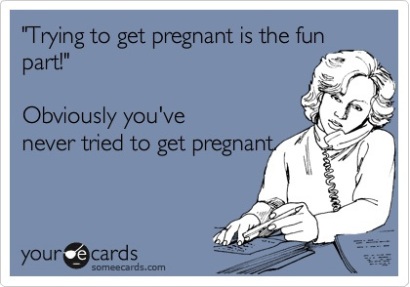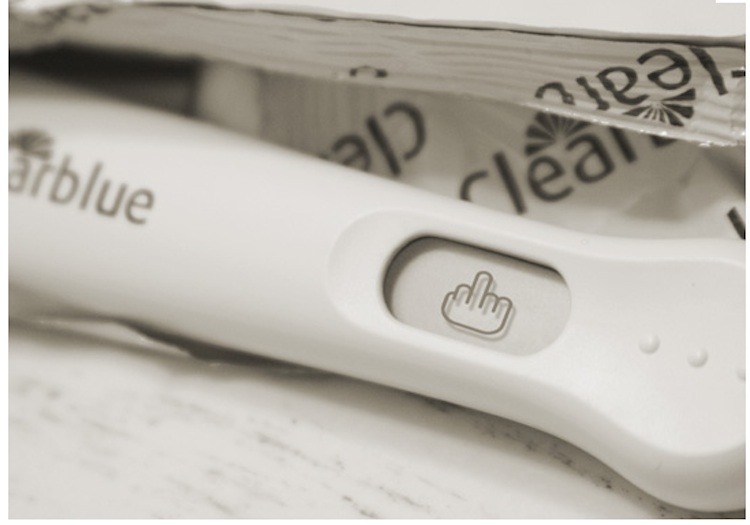For awesome, informative, and ULTRA science-y descriptions of the male and female reproductive systems, see parts 1 and 2 of this series: Part 1 Part 2
Now that we're all kinds of knowledgeable about our respective equipment, let's talk about how to actually go about the thing.

*Note - This is mostly for those of you who are fairly new to trying to conceive, haven't had fertility problems and just want to get ON with it already. If you're like me and none of this stuff works, then you might want to go see a doctor sometime between 6 - 12 cycles.*
So, basically, we women have something called a menstrual cycle (I hate the word menstrual, by the way). This is how a textbook cycle would go:
Follicular Phase (Cycle Days 1 - 14):
Cycle Days 1 - 5 (or 6 or 7 or 8 or whatever): Your period happens. Life is horrible, probably.
Cycle Days 7 - 14: You're getting ready to ovulate. Your ovaries are busy building up some follicles, one of which will mature enough to be THE EGG OF THE CYCLE and if you want to get pregnant, this is the week to get to it.
Cycle Day 14: You're ovulating! Congratulations! If you haven't already (you should have, though), do the deed today and tomorrow (and maybe the next day, if you really like your significant other).
Luteal Phase (Cycle Days 14 - 28):
Cycle Days 14 - 28: In the ttc world, this is known as the Two Week Wait (TWW). This is basically where you have tons of pregnancy symptoms, whether you're actually pregnant or not. If you are, your period probably won't appear. If you're not, you start over from Cycle Day 1. Please have some wine.
Notice I emphasized "textbook". Not everyone (far from everyone, most likely) actually ovulates on cycle day 14. The follicular phase varies from woman to woman. You might ovulate on cycle day 9 or cycle day 39. You might not ovulate at all. Some months (rarely) you might ovulate twice! Ovulation might change every month depending on stress levels, hormone issues, nutrition, exercise, etc, etc. It's a tricky business and if you're not paying attention, you might miss ovulation entirely, leaving your poor little egg hanging.
The luteal phase, on the other hand, is pretty constant and typically lasts 14 days from the date you ovulate. So, if you ovulate on cycle day 39 (you poor thing), your luteal phase should last about 14 days and (if not pregnant) you'd get your period again on cycle day 54, your new cycle day 1.
So, how do you know for sure when you ovulate? There's no way to know the exact moment (short of a very well-timed ultrasound, I guess), but there are some great ways to narrow it down to a nice 24 - 48 hour window:
1 - Ovulation Predictor Kits (OPKs). This is probably the easiest way to know when you're probably going to ovulate. You can buy them at pretty much any drugstore. They come in digital and non-digital form. The digitals, while expensive, give you a smiley face when you're getting ready to ovulate (within the next 12 - 36 hours, generally). The non-digitals display 2 lines, the control and test line, very much like a pregnancy test. When the test line is as dark or darker than the control line, ovulation should take place that day or the next, usually.
 |
| Mr. Smiley face is gently reminding you to get to it already. |
Which brings us to something that actually CAN confirm ovulation:
2 - Charting your basal body temperature (BBT). When used along with OPKs, this is a pretty surefire way to know A) that you're going to ovulate and B) that you actually DID ovulate. It's a lot more labor-intensive than just using opks, but if you like charts (and who doesn't!?), this is totally going to be up your alley.
Just to give more information than you're interested in, your basal body temperature (bbt) is your temperature upon waking, taken with a (get this) bbt thermometer, which is usually pink, for effect. During your follicular phase (pre-ovulation), your temperature will be lower. Once you ovulate, your bbt will be higher (by at least .4 degrees, usually). So, it's pretty easy to see when you ovulated by looking at your chart. Here's a VERY typical bbt chart, borrowed from some way more informative website:
So, it's pretty obvious that this person ovulated on CD 14, because her CD 15 temp was much higher than her previous temps, and it remained that way throughout the rest of her very textbook cycle.
There are some great sites for charting. I use both of these, because sometimes I get annoyed with one or the other for various reasons:
They are both absolutely free and you shouldn't sign up for the paid accounts. I've tried them and personally didn't find them all that useful or helpful. Free is always better, right?
So, here are the steps if you'd like to chart your own BBT from now on:
1. The night before: Set your alarm for a specific time in the morning. If you usually set your alarm anyway, because you're unlike me and actually wake up and do early things, then you're ahead of the game.
2. Place your bbt thermometer within easy reach. A nightstand would work. Pick a spot and be consistent with it every night. You may want to keep a pen and paper handy, unless you're good at making your phone remember things for you.
3. Wake up. Hopefully you slept well, because bbt readings can be thrown off by a bad night's sleep.
4. DON'T DO ANYTHING EXCEPT REACH FOR THE BLURRY PINK THING ON YOUR NIGHTSTAND AND TAKE YOUR TEMP. If you take your bbt after getting out of bed, you're doing it wrong.
5. Go back to sleep.
6. Oh, wait. Record the temp somewhere. (See step 2).
7. Then go back to sleep.
8. Wake up and excitedly plug the day's temp in your chart on one of the sites mentioned above, or your own paper chart if you're weird and ultra-ambitious about it.
It's a good idea to not skip days and to wake up at the same time every morning. Your BBT is a mysterious, fickle thing and, though it's awesome at confirming ovulation, it can get thrown off pretty easily.
Now that you know how to check for ovulation, the only other thing to do is the whole sex thing. (*Note - there are other ways to check for ovulation. Cervical mucus, cervical position, ovulation pain, etc...I'm too lazy to go into those things here, but they exist if you want to wash your hands frequently.) It (sex) is pretty easy, and if you need any visuals the internet is full of examples. There's one very important thing to remember, though:
SEX MUST OCCUR AT SOME POINT BEFORE OR DURING OVULATION. SEX AFTER OVULATION IS ALMOST POINTLESS FOR BABY-MAKING PURPOSES.
But it is useful for showing your significant other that you still love them and stuff, so go ahead and keep at it if you like them enough. So, yeah, it doesn't matter if you get down every day, every other day, every few days....once menstruation ends, get some sperm in your Fallopian tubes!

Alright, We Did All That Stuff. Now What? Also, We're Tired From All the Sex.
 |
| THAT is a long time to wait for a new GoT episode. |
At the end of it all, you will either get this:
Or this:

You know, depending on which type of tests you buy. Or, you may be a better person than I am and just wait for menstruation (ugh) to either begin or not. Hopefully it does not and you will never need to reference back to this amazingly relevant and helpful blog post again.
Good luck!!


No comments:
Post a Comment